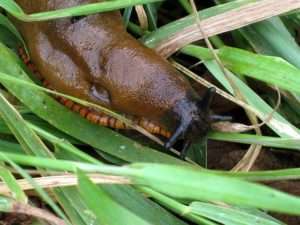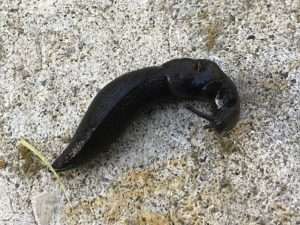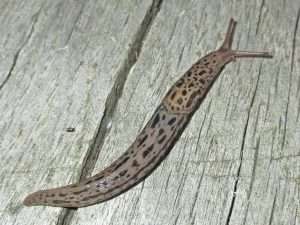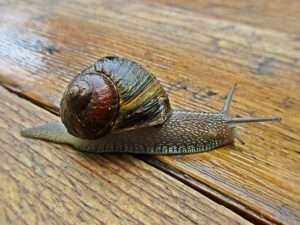As winter begins to give way to spring here on the southwest Washington coast, I’ve started to see signs of activity from some of the local cold-blooded wildlife. The occasional mosquito sunning itself by my kitchen door on a sunny morning, the large common garter snake (Thamnophis sirtalis) near the compost bin, a black-tailed bumblebee (Bombus melanopygus) emerging from a crevice in the garage. And then–there are the invasive slugs and snails.
Well, slugs, anyway. So far I’ve found a half a dozen of them, scattered in the yard or inexplicably making their way across my kitchen windowsills. (Indoors, mind you.) The snails probably aren’t far behind.
I haven’t yet seen any of our native species, like the Pacific banana slug (Ariolimax columbianus) or robust lancetooth (Haplotrema vancouverense). The banana slugs generally stick to the forests, for reasons I’ll talk about more in a minute. However, the lancetooths (lanceteeth?) roam far afield; as carnivorous snails, they hunt other gastropods, and the open areas favored by our overabundance of invasive slugs and snails suit them just fine.
Invasive Slugs and Snails
It’s National Invasive Species Awareness Week, just so you know, so it’s an appropriate time for me to showcase a few of the very slow invaders in my yard. They primarily hail from Europe, and were usually brought over by accident in shipments of plants or produce, though in the case of some edible snails the introduction was deliberate.
Three species of invasive slug are particularly common in my area, along with one snail:

Red slug (Arion rufus): This large slug can reach up to six inches in length, and is hard to miss with its often bright red color. However, some individuals may be brown, yellow, gray, and even black; the red edge around the foot is also common.

Black slug (Arion ater): Closely related to the red slug, similarly large, and often having a similar range of colors, these slugs are often pale colored when young. In fact, red A. ater looks so much like A. rufus that often dissection is the only way to tell which one you’ve got (not that most of us here care who’s eating our garden.)

Leopard slug (Limax maximus): Easier to distinguish from the Arion slugs, this species is usually gray or light brown with black spots all along its body, often in several longitudinal rows. They’re reportedly less active in attacking live plants, and will hunt and eat other slugs, native or invasive. However, as non-native species they do compete with native gastropods for resources.

European garden snail (Cornu aspersum): This large snail with a round, brown-colored shell was originally imported here as a poor person’s escargot. It is ubiquitous in open areas on the farm where I live, even in the dune grass near the beach, enough so that I’ve lost track of how many I’ve accidentally stepped on when walking from my car at night.
And a Few Natives, Too
Not all the local land molluscs are recent imports. I’ve seen a few natives in my area:

Pacific Banana Slug (Ariolimax columbianus): These are among my favorite invertebrates, and the closest the creepy-crawlies of the world get to a charismatic megafauna. They range in color from a bright Slip n’ Slide yellow, to a more muted yellow-green with darker spots, to a solid dark brown or black. Notice that unlike the leopard slug, their spots usually start after their mantle, and are larger, more random splotches. They can be almost ten inches in length, and are happiest chowing down on decaying matter on the forest floor.

Robust Lancetooth (Haplotrema vancouverense): These little snails were my introduction to the concept of snails as mighty hunters. Their relatively flat, yellowish shells litter the grassy areas here, and I am happy to cheer them on as they make their way through the night, chasing down the invasive slugs that proliferate there.

Pacific Sideband (Monadenia fidelis): Looking superficially like a garden snail, these native snails have a redder coloration both on body and shell, with a dark band around the outside of the whorl for which the snail is named. Like banana slugs, they’re happiest on the cool, damp forest floor.
There are, of course, plenty more species of terrestrial gastropod in the Pacific Northwest; these are just the ones I run across the most here in my little pocket thereof.
Taking Care in Gastropod Control
So why take the time to get to know your native vs. invasive slugs and snails? Well, for one thing, it’s mainly the invasive species that are responsible for wreaking havoc in the garden. Because many of the cultivated plants we raise, like vegetables, originated in Europe, European gastropods were already evolved to eat them. Invertebrates that eat plants have to be able to tolerate each plant species’ unique chemical compounds, and eating something they haven’t evolved alongside can make them sick or dead–just as we have certain plants we can’t eat but other animals can. So that means that if a banana slug or Pacific sideband did find themselves in your garden, they might not be able to tolerate eating the live plants they found there. And even if they did take a nibble, they tend to prefer decaying matter anyway.
But there’s another good reason to make sure you know which critter is which. Because native gastropods have evolved in their ecosystems over thousands of years, they’ve formed relationships with many other species of animal and plant there. When we remove a species from a place, we also destroy all those relationships, and the local web of life is weakened. By removing the invasive slugs and snails but sparing the native ones, we’re helping to strengthen local biodiversity, which benefits the other wildlife we enjoy seeing, like birds and garter snakes (both of which may snack on native slugs and snails themselves!)
Be mindful of what control methods you use in dealing with slugs and snails. Beer traps, slug bait, and other such general methods don’t discriminate on species; other small wildlife can die in beer traps as well by accident. Sprinkling salt on them may be satisfying, but it can pose a threat to native species as well, and damage or kill your plants. The best method is to pick the slugs and snails off plants, put them in a container of salt water, seal it, and leave them in there for a couple of days, then dispose of the contents by flushing it down the toilet. It does take more time, but you can identify each slug or snail you see, and rather than waiting for the destructive invaders to fall into a trap or take the bait, you can go ahead and send them to their demise immediately.

Thanks for linking to my profile of Haplotrema vancouverense! Always makes me happy when those profiles get utilized!
Hello, fellow nature nerd! I LOVE your site! I really appreciate that you get into detail about some species that often get overlooked, and tell a good story besides. Your photos are excellent as well. So thank YOU for creating such an excellent resource!
Also, very nice article! Our natives are, as you mention, quite beneficial, and don’t deserve to be lumped into the bad press that the invasives (properly) get.
Glad to have another cheerleader for our native terrestrial mollusks 🙂